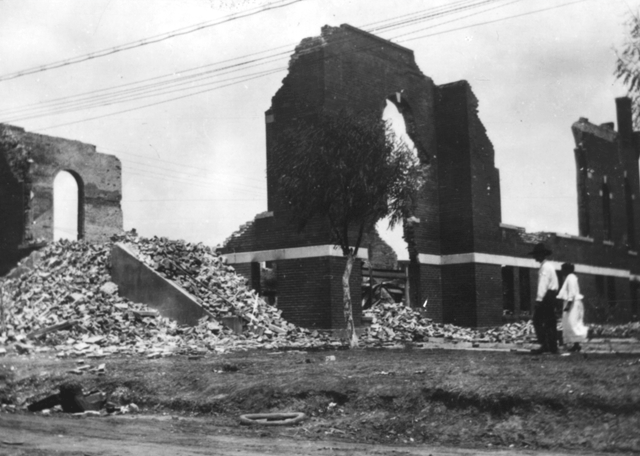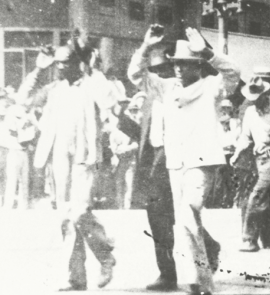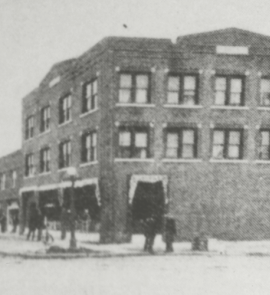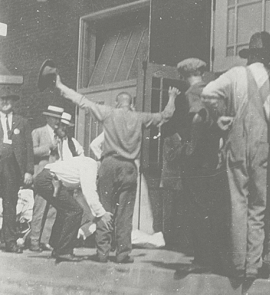Section 3: After the Massacre

Image from the Beryl Ford Collection/Rotary Club of Tulsa, Tulsa City-County Library and Tulsa Historical Society.
Reparations
From June 14, 1921, to June 6, 1922, an estimated $1.5–1.8 million in claims were made against the City of Tulsa. Most were disallowed, and not all property owners filed claims, so very little recompense was made for the homes, businesses and personal belongings destroyed or looted during the Massacre.
In January 1997, Oklahoma state Rep. Don Ross and Sen. Maxine Horner authored House Joint Resolution 1035, which in part sought $6 million in reparations, $5 million of which would go directly to descendants of the Massacre and the rest to children’s programs in North Tulsa. When brought to a vote, the resolution no longer contained a requirement for reparations but called for the creation of the Tulsa Race Riot Commission. This amended version passed the House and Senate, and the resulting commission began in-depth study of the 1921 event.
By April 1999, the commission knew of 51 still living Massacre survivors. Though the original mission did not call for reparations, this would become an important part in the commission’s final recommendations, which included a proposal for more than $33 million in restitution.
In February 2000, the commission voted to shorten the list of recommendations. While the state legislature approved measures for a memorial, scholarships and tax incentives for qualifying businesses in North Tulsa, no payments were made directly to victims or their families. So, the effort for monetary reparations became a local one.
Through the Reparations Gift Fund, the Tulsa Metropolitan Ministry distributed nearly $28,000 to Massacre survivors in April 2002. By then, the number of known survivors had grown to 131. In August 2002, the group disbursed an additional $12,000 to those same victims.
In November 2008, the memorial was built in John Hope Franklin Reconciliation Park. It opened in October 2010, nearly a decade after the commission’s final report.
In September 2020, a lawsuit was filed against the City of Tulsa and other agencies seeking reparations for defendants, which included the last three known survivors of the 1921 Tulsa Race Massacre.
The Search for Mass Graves
The Massacre’s death toll ranges from 150 to 300. Accounts of how victims were disposed of vary, from being “placed on flatbed railroad cars and moved by rail from Tulsa” to “being thrown in the Arkansas River or being incinerated.”1 The most frequent account is of victims being buried in mass graves.
The commission approved use of geophysics to search for potential grave sites at three locations in the late 1990s: Newblock Park, Oaklawn Cemetery and Booker T. Washington Cemetery. This action came about after studies found written evidence and funeral home records pointing to Massacre victims buried in unmarked graves at Oaklawn Cemetery.
In 2020, the search for mass graves in Oaklawn Cemetery resumed. Results have not yet been conclusive but several local organizations and media outlets, such as the Tulsa World, keep up to date on coverage of these ongoing efforts.
1. 1921, Oklahoma Commission to Study the Tulsa Race Riot. Tulsa Race Riot. Page 124. Createspace Independent Publishing Platform, 2001.
News Narrative
The Tulsa Race Massacre has been in the news cycle for many decades. This table shows a small portion of local, national and even international headlines and publications that have covered the Tulsa Race Massacre over the last 100 years, emphasizing when and how these news narratives changed or developed.
Visit the Research Center online or at Central Library to explore primary source newspapers and other reference articles related to the 1921 Tulsa Race Massacre.
TCCL Resources Used for Content in this Exhibit
Black Wall Street: From Riot to Renaissance in Tulsa’s Historic Greenwood District by Hannibal B. Johnson
Black Wall Street 100: An American City Grapples With Its Historical Racial Trauma by Hannibal B. Johnson
Death in a Promised Land: The Tulsa Race Riot of 1921 by Scott Ellsworth
Race Riot 1921: Events of the Tulsa Disaster by Mary E. Jones Parrish
Riot on Greenwood: The Total Destruction of Black Wall Street by Eddie Faye Gates
The Race Reader: A Literary Chronicle of Conflict and Oppression in the Middle of America by J. Ross
The Rise and Fall of Black Wall Street & The Seven Key Empowerment Principles by Robin Walker
2001 Report by the Oklahoma Commission to Study the Tulsa Race Riot of 1921
National Park Service’s 1921 Tulsa Race Riot Reconnaissance Survey






